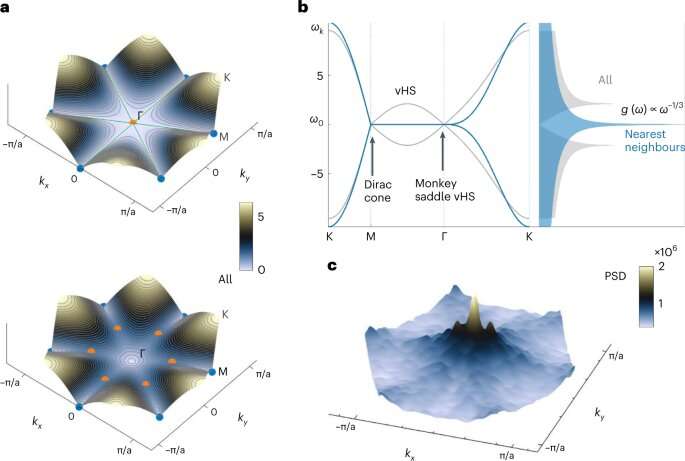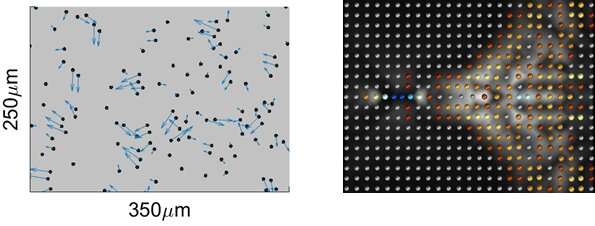
Flat bands and monkey saddles in hexagonal crystals. credit: nature physics (2023). DOI: 10.1038/s41567-022-01893-5
Starting with the advent of quantum mechanics, the world of physics has been divided between classical physics and quantum physics. Classical physics deals with the motions of things we normally see every day in the macroscopic world, while quantum physics explains the strange behaviors of elementary particles in the microscopic world.
Many solids or liquids are composed of particles that interact with each other at close distances, sometimes resulting in the appearance of “quasiparticles”. Quasiparticles are long-lived excitations that effectively behave as weakly interacting particles. Soviet physicist Lev Landau introduced the idea of quasiparticles in 1941, and it has since been very fruitful in quantum matter research. Some examples of quasiparticles include Bogolyubov quasiparticles (i.e., “broken Cooper pairs”) in superconductivity, excitons in semiconductors, and phonons.
Examining emerging collective phenomena in terms of quasiparticles has provided insights into a variety of physical settings, most notably into superconductivity, superfluidity, and more recently in the famous example of Dirac quasiparticles in graphene. But so far, the observation and use of quasiparticles has been limited to Quantum physics: In classical condensed matter, the collision rate is usually too high to allow long-lived particle-like excitations.
However, the standard view that quasiparticles are confined to quantum matter has recently been challenged by a group of researchers at the Center for Soft and Living Materials (CSLM) within the Institute for Basic Science (IBS), South Korea. They examined a classical system made of microparticles driven by viscous flow in a thin microfluidic channel. When particles are pulled in by the flow, they disturb the rheology around them, thus exerting hydrodynamic forces on each other.
Remarkably, the researchers found that these long-range forces cause particles to align into pairs. This is because a hydrodynamic interaction violates Newton’s third law, which states that forces between two particles must be equal in magnitude and opposite in direction. Instead, the forces are “anti-Newtonian” because they are equal and in the same direction, thus stabilizing the pair.

Left: experimental measurement of colloidal particles propelled into a thin microfluidic channel. Particles form hydrodynamically coupled stable pairs that move at the same speed (arrows). These pairs are the fundamental quasiparticles of the system. Right: Simulation of a hydrodynamic crystal, showing a quasiparticle pair (yellow and orange particles at far left) propagating in a hydrodynamic crystal, leaving behind a supersonic Mach cone of excited quasiparticles. The colors indicate the magnitude of the pair’s arousal, and the white background indicates their speed. Credit: Institute for Basic Sciences
The large number of particles paired up hinted that these are the long-lived primary excitations in the system—its quasiparticles. This hypothesis was proven correct when the researchers simulated a large two-dimensional crystal made of thousands of particles and examined its motion. Hydrodynamic forces between molecules make the crystal vibrate, like thermal phonons in a vibrating solid.
Pair quasiparticles diffuse through the crystal, catalyzing the formation of other pairs through a chain reaction. Quasiparticles travel faster than the speed of phonons, and so each pair leaves behind an avalanche of newly formed pairs, much like a Mach cone generated behind a supersonic jet. Finally, all these pairs collide with each other, which eventually causes the crystal to melt.

The spectrum of phonons in the hydrodynamic crystal displays Dirac cones, indicative of the generation of quasiparticle pairs. The zoom shows one of Dirac’s double cones. Credit: Institute for Basic Sciences
Fusion produced by pairs is observed in all crystal symmetries except for one particular case: the hexagonal crystal. Here, the 3D symmetry of the hydrodynamic interaction matches the crystal symmetry, and as a result, the initial excitations are very slow low-frequency phonons (not pairs as usual). In the spectrum, one sees a “flat band” where these ultraslow phonons condense. The interaction between flat-band phonons is highly collective and coherent, which is seen in the most pronounced and different fusion transition class.
In particular, when analyzing the spectrum of phonons, the researchers identified the typical conical structures of Dirac quasiparticles, just like the structure found in the electronic spectrum of graphene. In the case of a hydrodynamic crystal, the Dirac quasiparticles are simply pairs of particles, which are formed thanks to the flow-mediated “anti-Newtonian” interaction. This shows that the system can serve as a classical counterpart to the particles detected in graphene.
explains Tsvi Tusty, one of the corresponding authors of the paper.
Moreover, quasiparticles and flat bands are of particular interest in condensed matter physics. For example, flat bands have recently been observed in twisted double layers of graphene at a specific ‘magic angle’, and it just so happens that the hydrodynamic system studied in IBS CSLM exhibits a similar flat band in a much simpler 2D crystal.
Altogether, these results indicate that other emerging collective phenomena measured so far only in quantum systems can be detected in a variety of classically dissipative settings, such as energetic and live mattersays Hyuk Kyu Pak, one of the paper’s corresponding authors.
more information:
Imran Saeed, Quasiparticles, Flat Bands and Hydrodynamic Melting of Matter, nature physics (2023). DOI: 10.1038/s41567-022-01893-5. www.nature.com/articles/s41567-022-01893-5
Introduction of
Institute of Basic Sciences
the quote: Scientists observe ‘quasiparticles’ in classical systems for the first time (2023, January 26) Retrieved January 27, 2023 from https://phys.org/news/2023-01-scientists-quasiparticles-classical.html
This document is subject to copyright. Apart from any fair dealing for the purpose of private study or research, no part may be reproduced without written permission. The content is provided for informational purposes only.

“Beer aficionado. Gamer. Alcohol fanatic. Evil food trailblazer. Avid bacon maven.”
